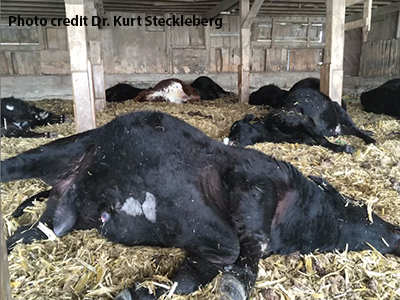Growing Beef Newsletter
September 2024, Volume 15, Issue 3
Awareness for Yew: Avoiding fall trimming and landscaping plant poisonings
Scott Radke, Clinical Associate Professor, DVM, MS, DABVT
 As fall begins following a year of abundant rainfall in the state, many are looking forward to tidying up around the yard in preparation for winter. Along with cutting grass, trimming of trees and shrubs that have grown over the summer is also commonly performed. With such outdoor activities soon to be taking place, individuals should take note of one plant in particular that is notorious for killing cattle.
As fall begins following a year of abundant rainfall in the state, many are looking forward to tidying up around the yard in preparation for winter. Along with cutting grass, trimming of trees and shrubs that have grown over the summer is also commonly performed. With such outdoor activities soon to be taking place, individuals should take note of one plant in particular that is notorious for killing cattle.
The Japanese yew (Taxus cuspidata) plant, is a seemingly innocent ornamental evergreen type plant that is widespread and often found decorating lawns and landscapes. However, this plant is considered to be one of the most toxic plants in North America. To put the toxic potential of this plant into perspective, a single handful of leaves is sufficient to kill an adult bull or cow. During the spring and early part of summer 2024, nine cases of yew poisoning were either reported to or diagnosed by the analytical chemistry services section at the Iowa State University Veterinary Diagnostic Laboratory (ISU VDL), with those cases resulting in more than 50 cattle deaths.
Although poisonings associated with this plant do occur when cattle are placed in a new environment or when they escape from their enclosures, most incidents involve the innocent provision of plant material to cattle (usually trimmings from landscaping) as an extra food source or snack without knowing how dangerous the plant is. Unlike many poisonous plants cattle avoid due to their noxious nature, yew appears to be palatable to cattle resulting in them gravitating towards it.
All parts of the plant, with exception of the red aril or berry, are toxic. The taxine alkaloids within the plant are believed to interfere with the electrical conduction within the heart resulting in failure. Following consumption, few if any clinical signs are noted outside of sudden death which may occur within minutes to hours. Unfortunately, cattle that consume yew are likely to die.
 Diagnosis of yew poisoning in cattle is fairly simple. Although no lesions are observed, the presence of yew leaves within the rumen are diagnostic. In some situations, animals die so suddenly that they have the plant in their mouth or esophagus.
Diagnosis of yew poisoning in cattle is fairly simple. Although no lesions are observed, the presence of yew leaves within the rumen are diagnostic. In some situations, animals die so suddenly that they have the plant in their mouth or esophagus.
Preventing exposure to and consumption of yew is critical because there is no antidote. In order to prevent poisonings, trimmings should be burned or disposed of in a proper area or container. Producers are encouraged to reach out to neighbors who may have this plant on their property and discuss the dangers presented to cattle. Due to the stability of the taxine toxins, drying out plants does not decrease the toxicity, meaning they remain a danger to cattle. In the event that yew trimmings are provided to cattle, all plant material -- from large branches to small sprigs of leaves -- must be removed. It is not enough to simply remove large branches. Cattle that have had access to yew should be monitored for at least 48 hours.

This monthly newsletter is free and provides timely information on topics that matter most to Iowa beef producers. You’re welcome to use information and articles from the newsletter - simply credit Iowa Beef Center.
Archived issues
